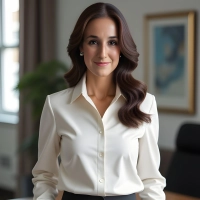10 Tips for Building Relationships With Journalists and Influencers
Navigating the world of media requires more than just a compelling story; it demands building genuine, strategic relationships with journalists and influencers. This article distills valuable lessons from seasoned professionals in the field, offering concrete strategies and expert insights to elevate one's media outreach. Embrace these curated tips to forge strong connections and become a go-to source for industry news and stories.
- Offer Value Upfront on Professional Platforms
- Position Yourself as a Reliable Source
- Engage with Content Before Pitching
- Show Genuine Interest in Their Work
- Provide Exclusive Value and Insights
- Conduct Thorough Research and Tailor Approach
- Engage Consistently Before Making an Ask
- Personalization Wins: Research and Engage First
- Offer Unique, High-Value Content First
- Build Long-Term Relationships Before Asking
Offer Value Upfront on Professional Platforms
Offering value upfront
To build strong relationships with journalists and influencers, reach out where/when they're most active and offer something genuinely useful. From my experience, the best way to connect isn't through personal social media like Facebook or Instagram but rather on professional platforms like LinkedIn or X.
Once we wanted to collaborate with a crypto influencer but got no response to direct messages on Twitter. However, we noticed on LinkedIn that he was launching a new merch line. Instead of pitching right away, I commented on his post, offering to feature the launch in our niche newsletter - reaching a highly relevant community. That got his attention, and the collaboration was a success.
The takeaway? Pay attention to where they're actively engaging, look for natural ways to add value

Position Yourself as a Reliable Source
One of the most effective ways to build strong relationships with journalists and influencers is to position yourself as a reliable, knowledgeable source rather than just pitching stories. Consistently providing valuable insights, expert commentary, and timely information builds trust and increases the likelihood of being featured in earned media coverage.
Example: Monsees & Mayer's Advocacy on Sexual Abuse Cases
At Monsees & Mayer, we've worked to establish relationships with investigative journalists covering legal and social justice issues. When advocating for the elimination of Missouri's statute of limitations for sexual abuse survivors, we didn't just send press releases—we:
Provided legal expertise on how outdated laws failed survivors.
Connected journalists with real survivor stories (with consent) to humanize the issue.
Offered timely updates on legislative efforts, positioning Monsees & Mayer as a go-to legal source.
The Outcome:
Earned media coverage in major news outlets, raising public awareness.
Stronger trust with journalists, leading to ongoing media requests for legal insights.
Increased public engagement, helping push the reform movement forward.
Final Takeaway:
Journalists and influencers seek credible, knowledgeable sources—not just press releases. By offering valuable insights, timely legal perspectives, and human impact stories, Monsees & Mayer has built lasting media relationships that drive awareness and advocacy.

Engage with Content Before Pitching
The key to building strong relationships with journalists and influencers is providing value before asking for anything. Instead of pitching right away, I focus on engaging with their content-commenting on their posts, sharing their work, and starting genuine conversations. When I finally reach out, it's not a cold pitch; it's a warm introduction.
A great example was when I wanted coverage for an e-commerce product launch. Instead of sending mass emails, I identified a few journalists who had written about similar brands. I engaged with their content for weeks, then sent a personalized pitch referencing their past articles and explaining why my product was relevant to their audience. Because the approach felt personal and relevant, one journalist picked it up, leading to a feature that drove a spike in traffic and sales.
The biggest lesson? Make it about them first. Journalists and influencers are bombarded with pitches-stand out by building a relationship before making your ask.

Show Genuine Interest in Their Work
Building media relationships starts with genuine interest in their work. Study each journalist or influencer and send a short note that fits their style. Sharing insights and fresh angles often grabs attention. A friendly message and a willingness to exchange useful ideas open doors for earned media coverage and help build long-term connections.
During a recent pitch a local influencer loved the angle I proposed. A brief note that matched her interests sparked our conversation, which grew into a feature story that broadened our coverage and built new connections. That simple, honest exchange proved that clear, respectful communication can create lasting media bonds.

Provide Exclusive Value and Insights
One of the most effective ways to build strong relationships with journalists and influencers is to provide them with exclusive value—whether it's unique insights, early access to news, or expert commentary that adds depth to their stories. Instead of just pitching stories, focus on becoming a reliable resource. Understand their beat, their past work, and the kind of narratives they resonate with.
For example, at Tecknotrove, we once reached out to a journalist covering defense technology with an exclusive preview of our military training simulator before its official launch. Instead of a standard press release, we arranged a hands-on experience, allowing them to interact with the simulator and speak directly with our engineers. This approach not only gave the journalist a richer, first-hand perspective but also led to an in-depth feature that was far more compelling than a generic news mention.
The key takeaway is to build relationships by offering journalists something truly valuable—access, insights, or expertise—rather than just a press release. That's what makes you memorable.

Conduct Thorough Research and Tailor Approach
To build relationships with journalists or influencers, my top tip is to conduct thorough research and tailor your approach to each individual outlet or influencer. Understand their interests and create story angles that resonate with their audience. A key example is when we embraced the rise of podcasts and reached out to top-tier shows, positioning our clients as thought leaders. By offering relevant insights and maintaining consistent outreach, we secured impactful podcast placements. Additionally, staying active on social media platforms like LinkedIn and Twitter helps us engage and build long-term, authentic relationships with key media figures.

Engage Consistently Before Making an Ask
Engage consistently and provide value before making an ask. Rather than pitching immediately, we build authentic connections by engaging with their content, sharing thoughtful insights, and positioning ourselves as a resource.
For example, when securing media placements for a FemFounder campaign, we identified a journalist covering female entrepreneurship in Forbes and began engaging with their articles by commenting on LinkedIn, resharing their content, and adding value to their discussions.
After several weeks of interaction, we reached out with a personalized pitch referencing their past work, offering exclusive insights on a trending topic in women-led businesses. Because we had already built rapport, the journalist responded positively, and the pitch resulted in a featured article that drove significant brand visibility. This approach ensures that media relationships are not transactional but built on trust and mutual benefit, increasing long-term PR success.

Personalization Wins: Research and Engage First
Personalization wins. Don't mass pitch—research their work, engage with their content, and offer value before asking for coverage.
Example: We secured a feature by first engaging with a journalist's LinkedIn posts, adding thoughtful comments. When we finally pitched, we referenced their past work and tied our story to a trend they covered. That personal touch led to coverage without a cold pitch getting ignored.

Offer Unique, High-Value Content First
The best way to build relationships with journalists and influencers is to offer unique, high-value content before asking for coverage. Instead of just pitching a story, we focus on providing assets that make their job easier-whether that's exclusive drone footage, real-time event coverage, or behind-the-scenes content that enhances their reporting.
Example: Drone Footage & Local News
One of the most effective ways we've secured organic media coverage is through high-quality drone footage of local events, major developments, and breaking news stories. Local news outlets often struggle to capture aerial perspectives, so when we proactively provide stunning footage of construction projects, community events, or severe weather incidents, they are more likely to credit and feature our content.
By offering free-use footage to local journalists, we've built strong media relationships that later resulted in direct features on our work and expertise in video production. It's a win-win:
* Journalists get visually compelling content.
* We get brand exposure and backlinks.

Build Long-Term Relationships Before Asking
Building relationships with journalists and influencers requires a long-term strategy, not just one-off pitches. The key is to engage with them before you need media coverage. Follow them on social media, comment on their work, and offer insights relevant to their beat. This builds trust and familiarity.
For example, a PR team secured a major interview for a client by first identifying a journalist who matched their target audience. They engaged with her on Twitter over shared interests for months before pitching a relevant story. The journalist connected them to a producer, leading to an interview that significantly boosted website traffic.
The takeaway? Relationship-building is about giving before asking. Help journalists with sources, insights, or content ideas, and when the time comes, they'll be more ready to cover your story.


